CCNA – IP Routing Questions
Here you will find answers to IP Routing Questions
Question 1
Refer to the exhibit. Assume that the routing protocol referenced in each choice below is configured with its default settings and the given routing protocol is running on all the routers. Which two conditional statements accurately state the path that will be chosen between networks 10.1.0.0 and 10.3.2.0 for the routing protocol mentioned? (Choose two)
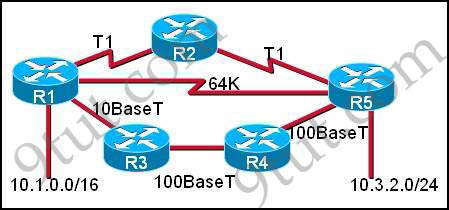
A. If OSPF is the routing protocol, the path will be from R1 to R3 to R4 to R5.
B. If OSPF is the routing protocol, the path will be from R1 to R2 to R5.
C. If OSPF is the routing protocol, the path will be from R1 to R5.
D. If RIPv2 is the routing protocol, the path will be from R1 to R3 to R4 to R5.
E. If RIPv2 is the routing protocol, the path will be from R1 to R5.
Answer: A E
Explanation
First we need to know the speed of these links:
+ T1: 1.544 Mbps
+ 10BaseT: 10 Mbps
+ 100BaseT (often referred to as FastEthernet): 100Mbps
OSPF chooses the best path via bandwidth while RIP only uses hop count (the sum of routers to reach the destination).
Therefore if OSPF is used, it will choose the path R1 -> R3 -> R4 -> R5 because these links have much higher speed than other paths -> A is correct.
But if RIP is used it only counts the number of routers to reach the destination (the less the better) so it will choose path R1 -> R5 (hop count: 1) -> E is correct.
Question 2
Refer to the exhibit. Which three statements are true about how router JAX will choose a path to the 10.1.3.0/24 network when different routing protocols are configured? (Choose three)
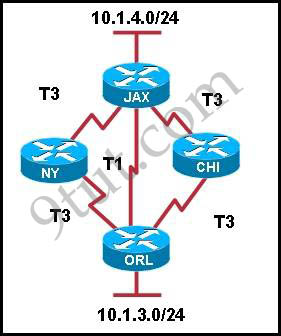
A. By default, if RIPv2 is the routing protocol, only the path JAX-ORL will be installed into the routing table.
B. The equal cost paths JAX-CHI-ORL and JAX- NY-ORL will be installed in the routing table if RIPv2 is the routing protocol.
C. When EIGRP is the routing protocol, only the path JAX-ORL will be installed in the routing table by default.
D. When EIGRP is the routing protocol, the equal cost paths JAX-CHI-ORL, and JAX-NY-ORL will be installed in the routing table by default.
E. With EIGRP and OSPF both running on the network with their default configurations, the EIGRP paths will be installed in the routing table.
F. The OSPF paths will be installed in the routing table, if EIGRP and OSPF are both running on the network with their default configurations.
Answer: A D E
Explanation
First we need to know the speed of these links:
+ T1: 1.544 Mbps
+ T3: 45 Mbps (each T3 line consists of 28 T1 lines)
RIP chooses the path with minimum hop count to reach the destination so it will choose JAX-ORL path -> A is correct.
EIGRP, by default, calculates metric via bandwidth & delay (metric = bandwidth + delay). Delay parameter can be ignored in this case so EIGRP will choose the path via metric. Both the path JAX-CHI-ORL and JAX- NY-ORL have the same metric (each includes two T3 lines) so EIGRP will use these paths -> D is correct.
EIGRP has lower Administrative Distance than OSPF (EIGRP: 90 < OSPF: 110) which is better -> EIGRP will be preferred to OSPF -> E is correct.
Question 3
Refer to the exhibit. The network administrator must establish a route by which London workstations can forward traffic to the Manchester workstations. What is the simplest way to accomplish this?
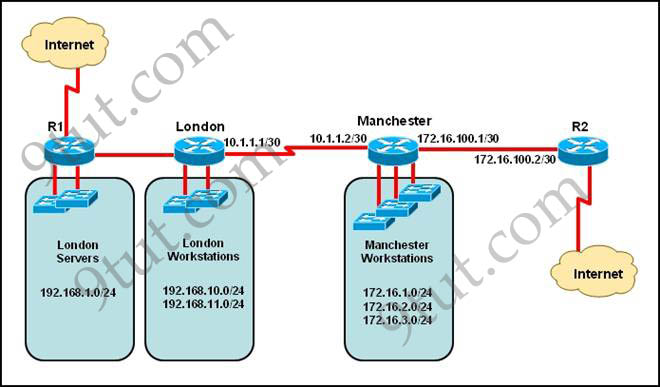
A. Configure a dynamic routing protocol on London to advertise all routes to Manchester.
B. Configure a dynamic routing protocol on London to advertise summarized routes to Manchester.
C. Configure a dynamic routing protocol on Manchester to advertise a default route to the London router.
D. Configure a static default route on London with a next hop of 10.1.1.1.
E. Configure a static route on London to direct all traffic destined for 172.16.0.0/22 to 10.1.1.2.
F. Configure Manchester to advertise a static default route to London.
Answer: E
Question 4
Which command is used to configure a default route?
A. ip route 172.16.1.0 255.255.255.0 0.0.0.0
B. ip route 172.16.1.0 255.255.255.0 172.16.2.1
C. ip route 0.0.0.0 255.255.255.0 172.16.2.1
D. ip route 0.0.0.0 0.0.0.0 172.16.2.1
Answer: D
Explanation
The simple syntax of static route:
ip route destination-network-address subnet-mask {next-hop-IP-address | exit-interface}
+ destination-network-address: destination network address of the remote network
+ subnet mask: subnet mask of the destination network
+ next-hop-IP-address: the IP address of the receiving interface on the next-hop router
+ exit-interface: the local interface of this router where the packets will go out
In the statement “ip route 0.0.0.0 0.0.0.0 172.16.2.1”:
+ 0.0.0.0 0.0.0.0: refer to any network
+ 172.16.2.1: the next-hop-IP-address
Question 5
If IP routing is enabled, which two commands set the gateway of last resort to the default gateway? (Choose two)
A. ip default-gateway 0.0.0.0
B. ip route 172.16.2.1 0.0.0.0 0.0.0.0
C. ip default-network 0.0.0.0
D. ip default-route 0.0.0.0 0.0.0.0 172.16.2.1
E. ip route 0.0.0.0 0.0.0.0 172.16.2.1
Answer: C E
Question 6
What must be set correctly when configuring a serial interface so that higher-level protocols calculate the best route?
A. bandwidth
B. delay
C. load
D. reliability
Answer: A
Explanation
Higher-level protocols (OSPF, EIGRP) calculate the best route mainly based on bandwidth so it must be set correctly -> A is correct.
Question 7
Which destination addresses will be used by Host A to send data to Host C? (Choose two)
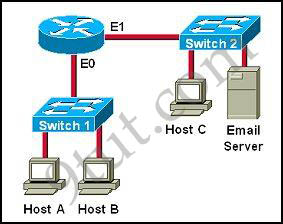
A. the IP address of Switch 1
B. the MAC address of Switch 1
C. the IP address of Host C
D. the MAC address of Host C
E. the IP address of the router’s E0 interface
F. the MAC address of the router’s E0 interface
Answer: C F
Explanation
While transferring data through many different networks, the source and destination IP addresses are not changed. Only the source and destination MAC addresses are changed. So in this case Host A will use the IP address of Host C and the MAC address of E0 interface to send data. When the router receives this data, it replaces the source MAC address with it own E1 interface’s MAC address and replaces the destination MAC address with Host C’s MAC address before sending to Host C -> C and F are correct.
Question 8
Which routing protocols can be used within the enterprise network shown in the diagram? (Choose three)
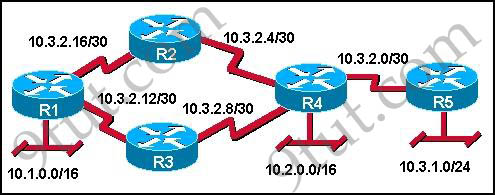
A. RIPv1
B. RIP v2
C. IGRP
D. OSPF
E. BGP
F. EIGRP
Answer: B D F
Explanation
RIPv1 & IGRP can not be used in this network because they do not support Variable Length Subnet Masking (VLSM) -> A and C are not correct.
BGP is a complicated routing protocol between different network (usually very big) or different Autonomous System. For example BGP can be used between two Internet Service Providers (ISP). The above network is very small in an enterprise so BGP is not a suitable choice -> E is not correct.
RIPv2 supports VLSM and can be used in networks which have less than 15 routers -> B is correct.
OSPF and EIGRP can be always used in most of enterprise networks -> D F are correct.
(But notice that EIGRP is a Cisco-proprietary routing protocol so it can be used in Cisco routers only)
Question 9
Which routing protocols will support the following IP addressing scheme? (Choose three)
Network 1 – 192.168.10.0 /26
Network 2 – 192.168.10.64 /27
Network 3 – 192.168.10.96 /27
Network 4 – 192.168.10.128 /30
Network 5 – 192.168.10.132 /30
A. RIP version 1
B. RIP version 2
C. IGRP
D. EIGRP
E. OSPF
Answer: B D E
Explanation
RIPv2, OSPF and EIGRP are classless routing protocol which support VLSM.
Question 10
Refer to the graphic. A static route to the 10.5.6.0/24 network is to be configured on the HFD router. Which commands will accomplish this? (Choose two)
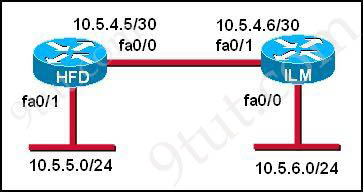
A. HFD (config) #ip route 10.5.6.0 0.0.0.255 fa0/0
B. HFD(config)# ip route 10.5.6.0 0.0.0.255 10.5.4.6
C. HFD(config)# ip route 10.5.6.0 255.255.255.0 fa0/0
D. HFD(config)# ip route 10.5.6.0 255.255.255.0 10.5.4.6
E. HFD(config)# ip route 10.5.4.6 0.0.0.255 10.5.6.0
F. HFD(config)# ip route 10.5.4.6 255.255.255.0 10.5.6.0
Answer: C D
Explanation
The simple syntax of static route:
ip route destination-network-address subnet-mask {next-hop-IP-address | exit-interface}
+ destination-network-address: destination network address of the remote network
+ subnet mask: subnet mask of the destination network
+ next-hop-IP-address: the IP address of the receiving interface on the next-hop router
+ exit-interface: the local interface of this router where the packets will go out
In the statement “ip route 10.5.6.0 255.255.255.0 fa0/0”:
+ 10.5.6.0 255.255.255.0: the destination network
+fa0/0: the exit-interface


